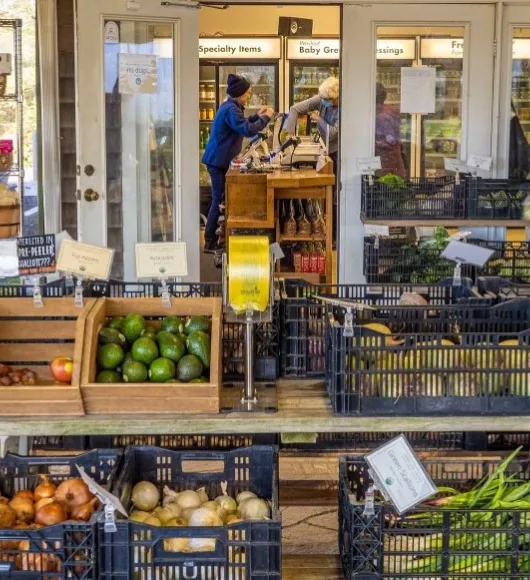Explore everything about producing, marketing and selling your product. We want to help you provide the best product possible and offer guidance on each step of the process.
Keep reading about selling your product below, get an overview of the beginning farmer's journey, or jump to a different section of the farmer's journey.
Food Safety
Building a good food safety plan is a top priority for a new and beginning farm business. There are both national and state regulations which apply to farm and ranch businesses. For federal compliance, the following resources below can be useful. For more information on your individual state’s requirements, please visit your State Department of Agriculture.
Standards and Certifications
The Agricultural Marketing Service's (AMS) quality grade standards and its independent third-party grading, certification, auditing, inspection, and laboratory analysis services are voluntary tools producers can use to help promote and communicate quality and wholesomeness to consumers. These standards and services can help new farmers be more competitive in the evolving marketplace and access new market opportunities.
Economic Trends in Agriculture
Track agricultural economics that affect product data using tools from these USDA agencies.
Local and Regional Food Systems
The consumer demand for locally-produced food is creating jobs and opportunity throughout rural America for farms, businesses and entrepreneurs that store, process, market and distribute food locally and regionally. Farm and business opportunities continue to increase as the market share of local and regional foods grows.
USDA provides many resources for new farmers who are interested in producing and marketing local food, organized under the Local and Regional Food Working Group.
Resources include USDA grants and loans and a wide range of tools that can help farmers, ranchers, other businesses, communities, and individuals looking to build or take advantage of local and regional food systems.

Sell Your Product
When it comes to selling your product there are many options such as local business, markets and schools. You can also sell directly to USDA or consider exporting.
Selling Locally
USDA's Local Food Directories help producers and consumers locate farmers markets, on-farm markets, CSAs, and food hubs. Managers and owners of local food entities are invited to enter and/or update their business information in the directories.
| Find Local Food Directories | Description |
|---|---|
| Farmers Markets | Farmers markets feature two or more farm vendors selling agricultural products directly to customers at a common, recurrent physical location. |
| On-Farm Markets | On-farm markets are managed by a single farm operator that sells agricultural and/or horticultural products directly to consumers from a location on their farm property or on property adjacent to that farm. |
| CSAs | Community supported agriculture (CSA) is a farm or network/association of multiple farms that offers consumers regular (usually weekly) deliveries of locally-grown farm products during one or more harvest season(s) on a subscription or membership basis. |
| Food Hubs | A food hub is a business or organization that actively manages the aggregation, distribution, and marketing of source-identified food products to multiple buyers from multiple producers, primarily local and regional producers. Food hubs strengthen the ability of these producers to satisfy local and regional wholesale, retail, and institutional demand. |
Farm to School
Schools across the country are increasingly interested in buying lunchroom products from local or regional producers, and schools are often a good market for new farmers. Farm to school grants and technical assistance can help link farmers to schools.
- See the results from our Farm to School Census showing the products schools are buying now and those they would like to buy in the future.
- See how many schools in your state participate in farm to school programs.
Developing Export Capacity
Exporting can be a valuable tool for new and beginning farmers to build new product markets, grow and expand businesses, and diversify revenue streams. USDA and our partners can help.
The Foreign Agricultural Service (FAS) can help beginning farmers and ranchers explore exporting opportunities through activities like trade missions, reverse buyer missions, trade leads, and trade shows highlighted on their web sites.
Selling Food to USDA
USDA Agricultural Marketing Service purchases a variety of 100% domestically produced and processed commodity food products. The wholesome, high-quality products purchased by USDA—collectively called USDA Foods—are delivered to schools, food banks, and households in communities across the country.
Learn More About Selling Food to USDA
Video: How to Become a USDA Vendor
How to Start a Farm with USDA
Get an overview of the beginning farmer's journey or jump to a specific page below.
Find Your Local Service Center
Los Centros de Servicio de USDA son lugares donde usted podrá contactarse con la Agencia de Servicios Agrícolas (FSA), el Servicio de Conservación de Recursos Naturales (NRCS), o empleados de Desarrollo Rural para discutir las necesidades de su negocio. Ingrese el estado y condado donde vive en el buscador para encontrar el Centro de Servicio más cercano y las oficinas de las agencias mencionadas. Si este buscador no funciona en su navegador web, por favor visite la página offices.usda.gov
Visite la página web de la Agencia de Gestión de Riesgos (RMA) para encontrar una oficina regional o de cumplimiento o para encontrar al agente de seguros más cercano.
Para obtener material traducido en español, revise nuestra página web de Traducciones, busque su centro de servicio local o informe a un empleado.
